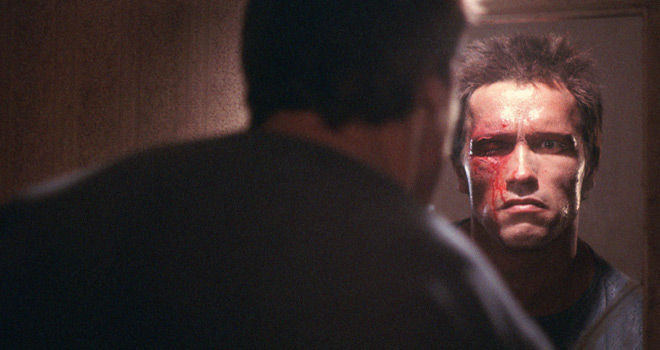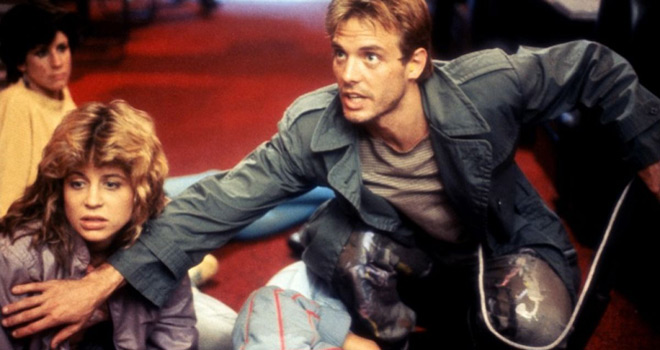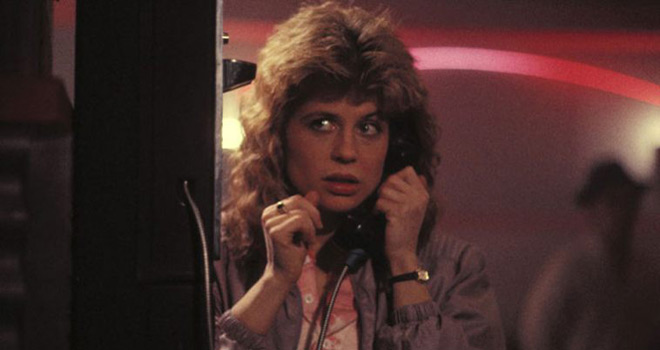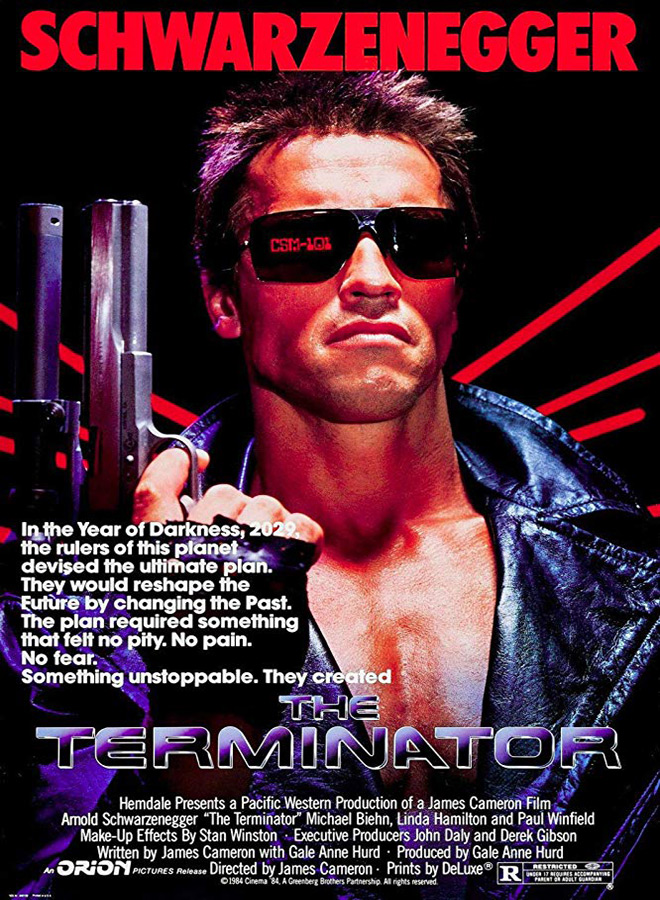What is the difference between James Cameron – director of 1981’s Piranha II: The Spawning and cinematographer of 1980’s Battle Beyond the Stars, – and James Cameron – director of 1997’s Titanic and 2009’s Avatar – the two biggest-selling films in the world for nearly a decade each? The answer: 1984’s The Terminator, a film that changed everything for the massively influential filmmaker. A cinematic classic originally released on October 26th back in 1984, it now celebrates 35 years of glory.

A Science Fiction film of a different kind, The Terminator not only put Cameron’s name on the marquee, much like 1979’s Alien character Ellen Ripley, it also introduced cinema to one of its more famous female action characters in Sarah Connor (Linda Hamilton: Children of the Corn 1984, Terminator 2: Judgment Day 1991). Additionally, it turned Arnold Schwarzenegger (Predator 1987, True Lies 1994) from a champion bodybuilder-playing actor to an enduring film icon.
The keyword being ‘enduring’, Schwarzenegger’s T-800 struggled through weaker sequels like 2003’s Terminator 3: Rise of the Machines, 2009’s Terminator: Salvation, and 2015’s Terminator Genisys. The latter two films even featured CGI recreations of 1984 Schwarzenegger, right down to the trimmed side-parting. Not so popular, what made the original The Terminator debut so effective? Where does it succeed over its weaker sequels? Furthermore, what faults does it have of its own?
For the first point, it used Schwarzenegger to the best of his abilities. He can look mean, tough, and intimidating, yet portraying convincing emotions is another matter. So, when Schwarzenegger met Cameron, keen to play the hero Kyle Reese, who was instead portrayed by Michael Biehn (Aliens 1986, The Abyss 1989), Cameron had other ideas. It is as hard to imagine Schwarzenegger pulling off Reese’s earnest, emotional lines as to imagine original Terminator choice Lance Henriksen overpowering him.
The idea behind the Terminator was that it could be anyone under the skin, that any random face in the crowd could be a killer. Hence the initial idea of going with Henriksen, or more infamously OJ Simpson. So, on the surface, Schwarzenegger goes against this grain as he is not exactly average. While his muscly frame does add to the suspense behind the story, the audience has no trouble believing a guy that big could be a machine able to tank bullets and go through a station’s worth of cops.

It does take more than size though. Schwarzenegger does some effective physical acting in the role, moving with steady, considered movements to add to the character’s robotic nature. He even spent weeks practicing how to operate guns to get into character, which got him one of his first and a few kudos on his acting from Soldier of Fortune magazine. Even his limited emotions become an advantage. His stern glares become more suspenseful, like his narrow missing of Connor in the nightclub when she bends down to pick something up.
The first key to success, the other would be that it keeps things relatively simple plot-wise. Being the first film, it does not suffer from having a backlog of lore to deal with. The Terminator and Reese go back to 1984 to find Connor – the former wants to kill her, and the latter wants to save her. The backstory (or front story as it were) is woven well too, through well-placed exposition by Reese to Connor, and through Reese’s nightmares of fighting on the front. Additionally, there is plenty of action, tech, and jargon for the big Sci-Fi fans, while retaining plenty of human moments for general moviegoers to relate to.
For example, while her 1991 Terminator 2: Judgment Day Connor gets the most attention, she still does a great job here as the humbler Connor. The writing, by both Cameron and Producer Gale Anne Hurd (The Abyss 1989, Armageddon 1999), helps in giving her a smooth arc from an everyday woman to a tougher figure. Though Hamilton’s performance really sold it, completing this arc without losing the nuance. She has flashes of steel at the beginning (her skepticism of Reese’s story) and is still gentle to admit her emotions by the end.
In contrast, Reese’s arc goes in the opposite direction. He starts off hard, even treated as another potential killer until the Terminator finds Connor. Yet, the audience does get subtle clues to him being the Terminator’s opponent, in that while the Terminator feels no pain, Reese feels pain a lot. His first scene has him wincing in physical agony, then his next has him suffering a traumatic flashback. He is much more human than the Terminator, though that does not necessarily make him a bad guy. Cameron would do something similar for Schwarzenegger in Terminator 2: Judgment Day, yet its build-up was less subtle, and thus a touch less effective, than what he does here.

From then on, his edges get gradually softened- from barking orders at Connor like a private, to admitting he feels for her beyond just being someone to protect. It completes his arc from knowing nothing but pain, to finally finding brief moments of respite in the past with Connor. On the other hand, or to alpha-types, this would seem like emasculation. Instead, Reese becomes a stronger, more complete character the more emotional he gets, aided by a sincere performance from Biehn. It is an aspect that feels quite forward for its time, unlike later projects by Cameron.
That said, it is still a very 1980s film. Its plot has aged well, and its setting was deliberately meant to be ‘the present’ for its time. However, the effects were not exactly space age. They are still impressive in their own right – the model Schwarzenegger head looks better than the one in Total Recall 6 years later, and the Go-Motion Terminator makes for a creepy figure. Still, they noticeably stick out and have aged worse than their low-tech equivalents. For example, the Terminator model skeleton is not shown from the waist down because it was propped up on a stagehand. Yet, thanks to the camera work, it looks more intimidating on screen than the Go-Motion one, or indeed later CGI ones.
So, The Terminator has dated effects with a simpler story and a lower budget than its successors. Yet, the way it makes the most of them has it standing much taller than many of them. It did not bog itself down with lore, it turned a limited actor into an icon, and good actors into great ones. The story may follow a familiar underdog structure, but its nuance, characters, and ideas help it feel much more modern than its big hairstyles and synth soundtrack would suggest. For a film from 1984, it still feels at home in 2019 as it did in 1984. That is why, across 35 years, the Terminator has always come back.






No comment